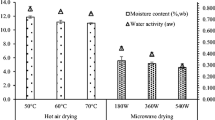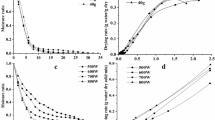Abstract
Garlic (Allium sativum L.) leaves, or green garlic characterized by a mild flavour, were a rich source of biologically active compounds as was found in garlic cloves. Influence of microwave drying (100–450 W) on the color, phenolics profile and radical scavenging activity of garlic leaves was studied. Effect of microwave power density level (W/g DM) on drying kinetics modelling was also investigated. Page’s model was found to be the best for fitting the experimental drying kinetics. Specific energy consumption increased with increasing microwave power from 80 to 137 MJ/kg of water at 100 and 450 W, respectively, whereas the energy efficiency decreased. Drying at 450 W produced a very distinct product because the sample’s ΔE value (24.87) was higher than those dried at lower microwave powers (ΔE = 14.66–16.86). Analysis by liquid chromatography coupled with mass spectrometry of garlic extracts resulted in identification of 5 phenolic acids and 11 flavonoids. Total identified phenolics in the fresh leaves was 1.28 mg/g extract, which increased for dried leaves at 100 W (5.6 mg/g extract), then gradually decreased to 2.7 mg/g extract at 450 W. Quercetin 3-O-rhamnoside was the main flavonoid extracted with 4 mg/g extract for the sample dried at 100 W. Drying garlic leaves at 100 W seems to be better in terms of lowest specific energy consumption and maximum phenolics extraction yield (12.45 g extract/100 g DM) and thereby enhanced antioxidant activity as evaluated by DPPH• radical-scavenging activity.
Graphical Abstract




Similar content being viewed by others
Data availability
All data and materials are available upon reasonable request from the corresponding author.
Abbreviations
- a, b and c:
-
Are the empirical constants in drying models
- K:
-
Is the slope
- m:
-
Is the sample mass (kg)
- \(\mathrm{MR}=\frac{{\mathrm{X}}_{\mathrm{t}}}{{\mathrm{X}}_{0}}\) :
-
Is the moisture ratio (dimensionless)
- N:
-
Is the number of observations
- n:
-
Is the positive integer empirical constant
- P:
-
Is the microwave power (W)
- R2 :
-
Is the determination coefficient
- RMSE:
-
Is the root mean square error
- SD:
-
Is the standard deviation
- t:
-
Is the drying time (min, s)
- X0 :
-
Is the initial moisture content (kg water/kg dry matter (DM))
- Xeq:
-
Is the equilibrium moisture content (kg water/kg DM)
- Xt :
-
Is the moisture content at any time (kg water/kg DM)
- Xt+Δt :
-
Is the moisture content at t + Δt (kg water/kg DM)
- χ2 :
-
Is the reduced chi-square
References
Singh R, Singh K (2019) Garlic: A spice with wide medicinal actions. J Pharmacogn Phytochem 8:1349–1355
Sharma GP, Prasad S (2004) Effective moisture diffusivity of garlic cloves undergoing microwave-convective drying. J Food Eng 65:609–617
Sharma GP, Prasad S (2006) Optimization of process parameters for microwave drying of garlic cloves. J Food Eng 75:441–446
Feng Y, Xu B, Yagoub AEA et al (2021) Role of drying techniques on physical, rehydration, flavor, bioactive compounds and antioxidant characteristics of garlic. Food Chem 343:128404
Fredotović Ž, Puizina J (2019) Edible Allium species: Chemical composition, biological activity and health effects. Ital J Food Sci 31:1
Feng H, Yin Y, Tang J (2012) Microwave drying of food and agricultural materials: basics and heat and mass transfer modeling. Food Eng Rev 4:89–106
Bal LM, Naik SN, Satya S, Kar A (2017) Changes in tissue structure and physico-chemical quality characteristics of bamboo shoot slices during microwave drying process. J Food Meas Charact 11:1203–1209
de Souza AU, Corrêa JLG, Tanikawa DH et al (2022) Hybrid microwave-hot air drying of the osmotically treated carrots. LWT 156:113046
Pateiro M, Vargas-Ramella M, Franco D et al (2022) The role of emerging technologies in the dehydration of berries: Quality, bioactive compounds, and shelf life. Food Chem X 16:100465
Apinyavisit K, Nathakaranakule A, Soponronnarit S, Mittal GS (2017) A comparative study of combined microwave techniques for longan (Dimocarpus longan Lour.) drying with hot air or vacuum. Int J Food Eng 13:7
Özkan Karabacak A (2019) Effects of different drying methods on drying characteristics, colour and in-vitro bioaccessibility of phenolics and antioxidant capacity of blackthorn pestil (leather). Heat Mass Transf 55:2739–2750
Halil T, Tamer CE, Suna S, Özkan Karabacak A (2020) Investigations of some quality parameters and mathematical modeling of dried functional chips. Heat Mass Transf 56:1099–1115
Doymaz I, Kipçak A, Piskin S (2015) Microwave drying of green bean slices: drying kinetics and physical quality. Czech J Food Sci 33:367–376
Dincer I, Sahin AZ (2004) A new model for thermodynamic analysis of a drying process. Int J Heat Mass Transf 47:645–652
Soysal Y, Öztekin S, Eren Ö (2006) Microwave drying of parsley: modelling, kinetics, and energy aspects. Biosyst Eng 93:403–413
Sadi T, Meziane S (2015) Mathematical modelling, moisture diffusion and specific energy consumption of thin layer microwave drying of olive pomace. Int Food Res J 22:494–501
Jdir H, Jridi M, Mabrouk M et al (2017) The rocket, Diplotaxis simplex, as a functional ingredient: LC-ESI-MS analysis and its effect on antioxidant and physical properties of bread. J Food Nutr Res 5:197–204
Zouari N, Fakhfakh N, Zouari S et al (2011) Chemical composition, angiotensin I-converting enzyme inhibitory, antioxidant and antimicrobial activities of essential oil of Tunisian Thymus algeriensis Boiss. et Reut. (Lamiaceae). Food Bioprod Process 89:257–265
Calín-Sánchez Á, Lipan L, Cano-Lamadrid M et al (2020) Comparison of traditional and novel drying techniques and its effect on quality of fruits, vegetables and aromatic herbs. Foods 9:1261
Guemouni S, Mouhoubi K, Brahmi F et al (2022) Convective and microwave drying kinetics and modeling of tomato slices, energy consumption, and efficiency. J Food Process Eng 45:e14113
Zahoor I, Khan MA (2019) Microwave assisted convective drying of bitter gourd: drying kinetics and effect on ascorbic acid, total phenolics and antioxidant activity. J Food Meas Charact 13:2481–2490
Horuz E, Bozkurt H, Karataş H, Maskan M (2018) Simultaneous application of microwave energy and hot air to whole drying process of apple slices: drying kinetics, modeling, temperature profile and energy aspect. Heat Mass Transf 54:425–436
Bozkir H, Rayman Ergün A, Tekgül Y, Baysal T (2019) Ultrasound as pretreatment for drying garlic slices in microwave and convective dryer. Food Sci Biotechnol 28:347–354
Zielinska M, Ropelewska E, Xiao H-W et al (2020) Review of recent applications and research progress in hybrid and combined microwave-assisted drying of food products: Quality properties. Crit Rev Food Sci Nutr 60:2212–2264
Jha P, Meghwal M, Prabhakar PK (2021) Microwave drying of banana blossoms (Musa acuminata): Mathematical modeling and drying energetics. J Food Process Preserv 45:e15717
Pinar H, Çetin N, Ciftci B et al (2021) Biochemical composition, drying kinetics and chromatic parameters of red pepper as affected by cultivars and drying methods. J Food Compos Anal 102:103976
Kaveh M, Abbaspour-Gilandeh Y, Fatemi H, Chen G (2021) Impact of different drying methods on the drying time, energy, and quality of green peas. J Food Process Preserv 45:e15503
Bennamoun L, Belhamri A (2006) Numerical simulation of drying under variable external conditions: Application to solar drying of seedless grapes. J Food Eng 76:179–187
Adekunte AO, Tiwari BK, Cullen PJ et al (2010) Effect of sonication on colour, ascorbic acid and yeast inactivation in tomato juice. Food Chem 122:500–507
Zielinska M, Zapotoczny P, Alves-Filho O et al (2013) A multi-stage combined heat pump and microwave vacuum drying of green peas. J Food Eng 115:347–356
Đurović S, Nikolić B, Luković N et al (2018) The impact of high-power ultrasound and microwave on the phenolic acid profile and antioxidant activity of the extract from yellow soybean seeds. Ind Crops Prod 122:223–231
Sharma M, Hussain S, Shalima T et al (2022) Valorization of seabuckthorn pomace to obtain bioactive carotenoids: An innovative approach of using green extraction techniques (ultrasonic and microwave-assisted extractions) synergized with green solvents (edible oils). Ind Crops Prod 175:114257
Benali T, Bakrim S, Ghchime R et al (2022) Pharmacological insights into the multifaceted biological properties of quinic acid. Biotechnol Genet Eng Rev 1–30
Magar RT, Sohng JK (2020) A review on structure, modifications and structure-activity relation of quercetin and its derivatives. J Microbiol Biotechnol 30:11–20
Chen J, Li G, Sun C et al (2022) Chemistry, pharmacokinetics, pharmacological activities, and toxicity of Quercitrin. Phyther Res 36:1545–1575
Sarkar C, Chaudhary P, Jamaddar S et al (2022) Redox activity of flavonoids: Impact on human health, therapeutics, and chemical safety. Chem Res Toxicol 35:140–162
Hossain MA, Bala BK (2007) Drying of hot chilli using solar tunnel drier. Sol Energy 81:85–92
Chinenye NM, Ogunlowo AS, Olukunle OJ (2010) Cocoa bean (Theobroma cacao L.) drying kinetics. Chil J Agric Res 70:633–639
Page GE (1949) Factors influencing the maximum rates of air drying shelled corn in thin layers [MS thesis]. Purdue University, West Lafayette, Indiana
Tunde-Akintunde TY, Ogunlakin GO (2013) Mathematical modeling of drying of pretreated and untreated pumpkin. J Food Sci Technol 50:705–713
Mujić I, Bavcon Kralj M, Jokić S et al (2014) Characterisation of volatiles in dried white varieties figs (Ficus carica L.). J Food Sci Technol 51:1837–1846
Corzo O, Bracho N, Pereira A, Vásquez A (2008) Weibull distribution for modeling air drying of coroba slices. LWT-Food Sci Technol 41:2023–2028
Author information
Authors and Affiliations
Contributions
Amna Chahbani: conceptualization, methodology and writing original draft; Nacim Zouari and Mourad Jridi: writing, review and editing; Halima Elhatmi: color measurement; Nahed Fakhfakh: supervision.
Corresponding author
Ethics declarations
Ethics approval
Not applicable.
Consent to participate
The authors declare their consent to participate in this article.
Consent for publication
The authors declare their consent to publish this article.
Conflict of interest
The authors declare no competing interests.
Additional information
Publisher's Note
Springer Nature remains neutral with regard to jurisdictional claims in published maps and institutional affiliations.
Rights and permissions
Springer Nature or its licensor (e.g. a society or other partner) holds exclusive rights to this article under a publishing agreement with the author(s) or other rightsholder(s); author self-archiving of the accepted manuscript version of this article is solely governed by the terms of such publishing agreement and applicable law.
About this article
Cite this article
Chahbani, A., Zouari, N., Elhatmi, H. et al. Microwave drying of garlic (Allium sativum L.) leaves: kinetics modelling and changes in phenolic compounds profile. Heat Mass Transfer 59, 1677–1685 (2023). https://doi.org/10.1007/s00231-023-03359-7
Received:
Accepted:
Published:
Issue Date:
DOI: https://doi.org/10.1007/s00231-023-03359-7




